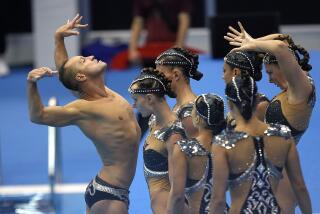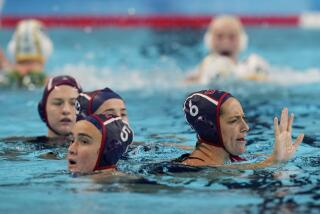They’ve Finally Hit It Right on the Nose : Olympic trials: U.S. has invisible nose clips to go with Josephson twins in synchronized swimming.
It was Dick Klein, the NBC football director, who planted the idea in Betty Watanabe’s head: She had to do something about those nose clips worn by synchronized swimmers.
“A director gets fixated on them,” Klein told Watanabe, who is director of U.S. Synchronized Swimming. “You have some of the most attractive female athletes, and that clip takes away from the beauty.”
Klein knew firsthand because he doubled as the director of NBC’s coverage of synchronized swimming at the 1988 Olympics.
But when Juan Antonio Samaranch, IOC president, and Peter Diamond, NBC’s Olympic head, also mentioned the nose clips, she knew it was serious. From those comments, Watanabe headed a project that recently produced the first effective nose clip that can be concealed inside a swimmer’s nose.
Said Watanabe’s assistant, Laura LaMarca: “Another country has one, but the swimmers have to blow it out of their nose to get it out and it is (unattractive).”
Unattractive is the opposite of what the sport’s officials try to promote, but beauty is only part of the package.
Though synchronized swimming is often ridiculed, it is an Olympic medal sport that requires extensive training and demanding athletic endurance.
The United States is recognized as having the top synchronized swimmers in the world, and the majority of them will be in Pasadena this weekend at the U.S. Olympic trials trying to win the right to advance to Barcelona, Spain. The trials, held at the Amateur Athletic Foundation’s Rose Bowl Aquatics Center, begin today with the required figures competition and continue through Sunday.
“Once people see the sport, they usually quit making fun of it because they realize how hard it is, “ Watanabe said.
At a restaurant last fall, Watanabe approached a table where Klein was sitting with Joe Namath and others. When Klein introduced her as being with U.S. Synchronized Swimming, the men at the table broke into laughter.
“But then Klein started defending the sport, telling these guys how hard it is,” Watanabe said. “And I didn’t have to defend it at all.”
The sport has come a long way since the early 1940s, when Esther Williams popularized in film a sort of water ballet replete with flowered bathing caps. It was also in the early 1940s that American men quit competing in the sport, presumably because there was no economic future.
“When we started out, we wore leotards and gloves, and performed just a notch above Esther Williams,” said Sarah Josephson, who along with twin sister Karen form the top-ranked duet team in the world.
The Josephsons, 28, have been in the sport for 20 years. They won a silver medal at the 1988 Olympics and retired, but then quickly changed their minds and returned to competition. They have not lost a competition since 1988.
They are renowned in their sport for the difficult spins that they do upside down in the water. Their prowess is such that they help speed swimmers with their sculling technique. Olympian Matt Biondi was a recent student.
“We have been doing this since we were 6, and we fell in love with the sport,” Karen said. “We understand it when people make fun of it, but the appreciation of the sport is increasing. But we do it for the enjoyment and the personal challenge and the satisfaction it gives us.”
Notes
Only one soloist and one duet will be chosen for the Olympics from 36 competitors. . . . Today’s figures competition, which counts as 50% of the final score, starts at 9:30 a.m. and is free to the public. Friday’s preliminary solo competition starts at 10:15, with the duet portion beginning at 3:15. Tickets are $7. Saturday, the solo finals begin with figures at 9:30 a.m., followed by the solo finals at 2 p.m. Sunday’s duet finals are at 2 p.m. Tickets for Saturday and Sunday are $13.
More to Read
Go beyond the scoreboard
Get the latest on L.A.'s teams in the daily Sports Report newsletter.
You may occasionally receive promotional content from the Los Angeles Times.






